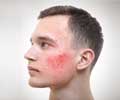The level of pleasure of scratching varies with the location of the itch, according to an expert.

While previous studies by Yosipovitch have shown the pleasurability of itching, analysis of itch relief at different body sites and related pleasurability had not been performed until now.
"The goal of this study was to examine the role of the pleasurability of scratching in providing relief for itch," Yosipovitch explained.
"We first evaluated whether itch intensity was perceived differently at three body sites, and then we investigated the potential correlation between the pleasurability and the itch relief induced by scratching," he explained.
Yosipovitch and colleagues induced itch on the ankles, forearms and backs of 18 study participants with cowhage spicules, which come from a type of legume found in tropical areas that are known to cause intense itching.
The spicules were rubbed gently in a circular motion for 45 seconds within a small area of the skin and removed with adhesive tape once itch was induced.
Advertisement
Their results show that itch was perceived most intensely at the ankle and back, while the perception of itch and scratching relief were less pronounced on the forearm. Another major finding of the paper, as Yosipovitch explains, is that "the pleasurability of scratching the ankle appears to be longer lived compared to the other two sites."
Advertisement
Yosipovitch said that while it is known that small nerve fibers are involved in unpleasant sensations such as itch and pain, he and other researchers now suspect that there are also specific nerve fibers involved in pleasure.
"If we could translate this to a treatment that induces a pleasurable relief sensation without damaging the skin, we may be able to help itchy patients," he said.
The study was published online this month by the British Journal of Dermatology.
Source-ANI









